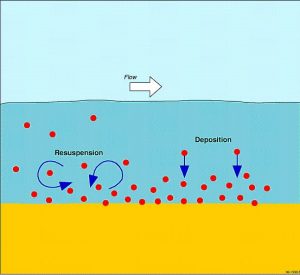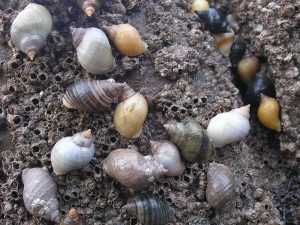Home » Environmental Priorities » Pollution »

Coastal marine sediments, particularly those in estuarine environments, are home to a wide range of benthic organisms including small invertebrates, marine plants, and flatfish species. This type of seafloor maintains a delicate balance that can be easily disturbed by human activity such as shipping traffic, bottom trawling, and dredging. These activities can lead to resuspension of sediments in the water column creating many problems for marine life. These problems include: eutrophication, alteration of sediment structure, burial and smothering, increased turbidity, and chemical disturbance (OSPAR, 2011).

Chemical disturbance refers to the remobilisation of toxic materials, such as heavy metals (e.g. Lead (Pb) and mercury (Hg)) which can have adverse effects on marine creatures. One such toxin is Tributyltin (TBT). TBT is a biocide that was used to prevent biofouling on ships’ hulls. Despite being phased out in 2008, by the International Maritime Organization, its effects are still a concern as it can remain in the water column and sediment for up to 20 years. TBT has been shown to pose a particular risk to molluscan species like the dogwhelk (Nucella lapillus). This whelk takes in TBT with its prey and results in a build-up of the toxin leading to reproductive abnormalities which can in turn prevent successful production of larvae (Murphy et al., unpublished).
Resuspension of sediments can also significantly increase the level of turbidity in a water column also. Increases in turbidity (cloudiness of water) can limit the amount of light that can penetrate the water column, posing a threat to light dependent organisms like marine plants and photosynthetic phytoplankton. Without light, these organisms eventually die, removing a food source for any herbivorous creatures, and subsequently leading to eutrophication and hypoxic dead zones due to the breakdown of dead organisms. Large levels of sedimentation, caused predominantly by dredging or dumping, can also crush and smother many delicate marine flora and fauna.

Between the year 2009 and 2013 almost 3 million tonnes of sediments were dumped into the sea, with up to 56 tonnes of this being comprised of purely toxic metals (OSPAR, 2013). Coastal developments such as harbour expansions may exascerbate this. Although resuspension of sediments due to harbour expansion is usually a temporary, localised issue, it could still have profound long term effects for numerous filter feeding species which live in the muddy sand around marina macroenvironments (MERC Contractors, 2007). Shipping traffic in busy fishing areas may pose long term issues, as the sediment disturbance is continuous and can only be stopped with the halting of shipping traffic, which in turn would cause countless issues for any businesses relying on this traffic.

